Fall 2018: Needs Analysis of Customer Service at People’s Credit Union
VerifiedAdded on 2023/06/04
|8
|2340
|84
Report
AI Summary
This report conducts a needs analysis for The People’s Credit Union, focusing on the customer service issues within its call center. The analysis identifies gaps between the company's desired high-quality service and the reality of rude, unhelpful, and uninformed customer service agents. It explores the root causes of these gaps, including inadequate employee orientation and training, recruitment practices, and potential issues with the working environment, such as excessive overtime. The report suggests that training is only part of the solution and recommends improvements to the recruitment process and the creation of a more supportive work environment. It also outlines steps for organizational, task, and person analyses to identify and address gaps, and discusses potential obstacles to conducting a thorough needs analysis, such as a lack of defined quality benchmarks and data availability. The ultimate goal is to improve customer satisfaction and reduce employee turnover by aligning employee performance with the Credit Union's service quality standards.
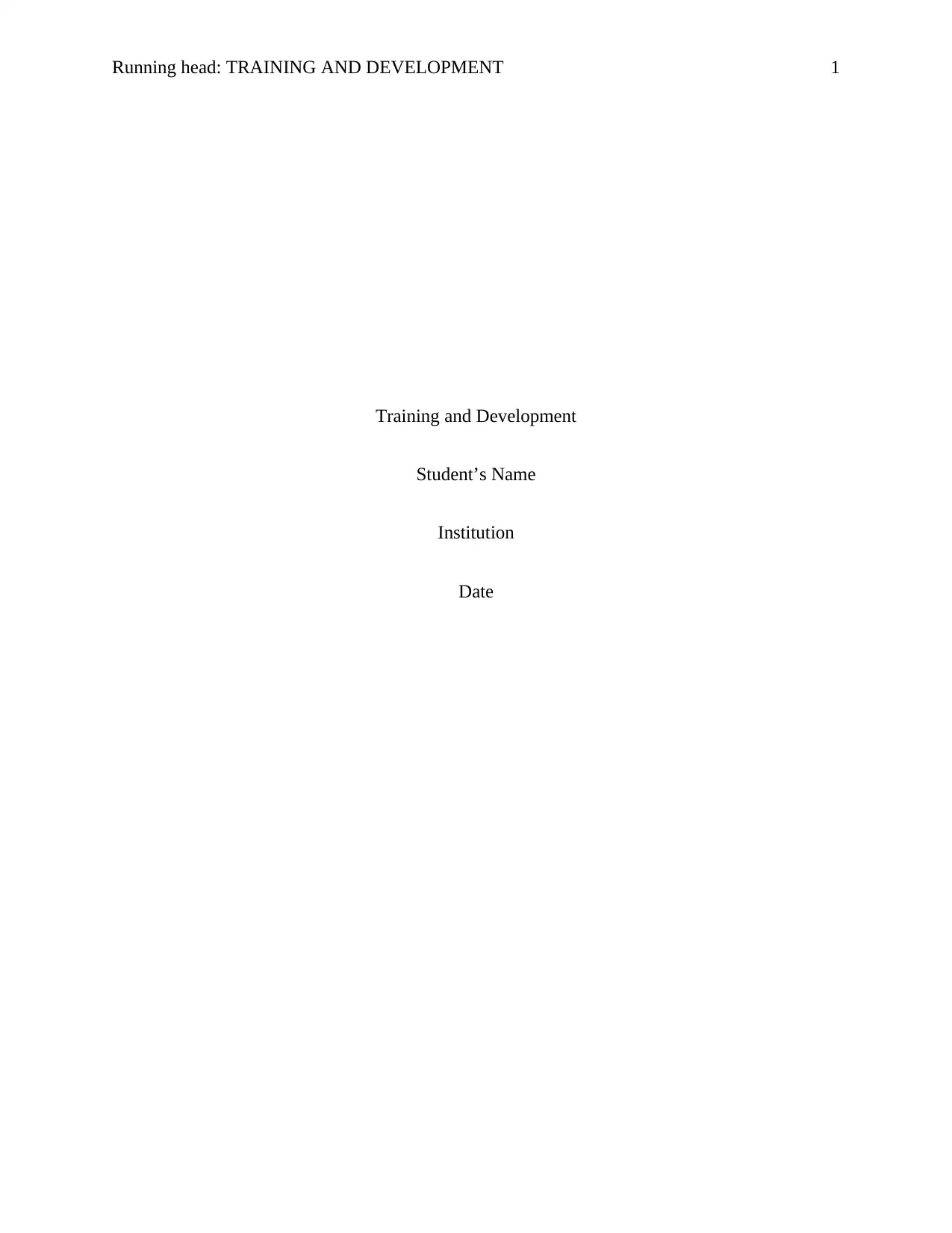
Running head: TRAINING AND DEVELOPMENT 1
Training and Development
Student’s Name
Institution
Date
Training and Development
Student’s Name
Institution
Date
Paraphrase This Document
Need a fresh take? Get an instant paraphrase of this document with our AI Paraphraser
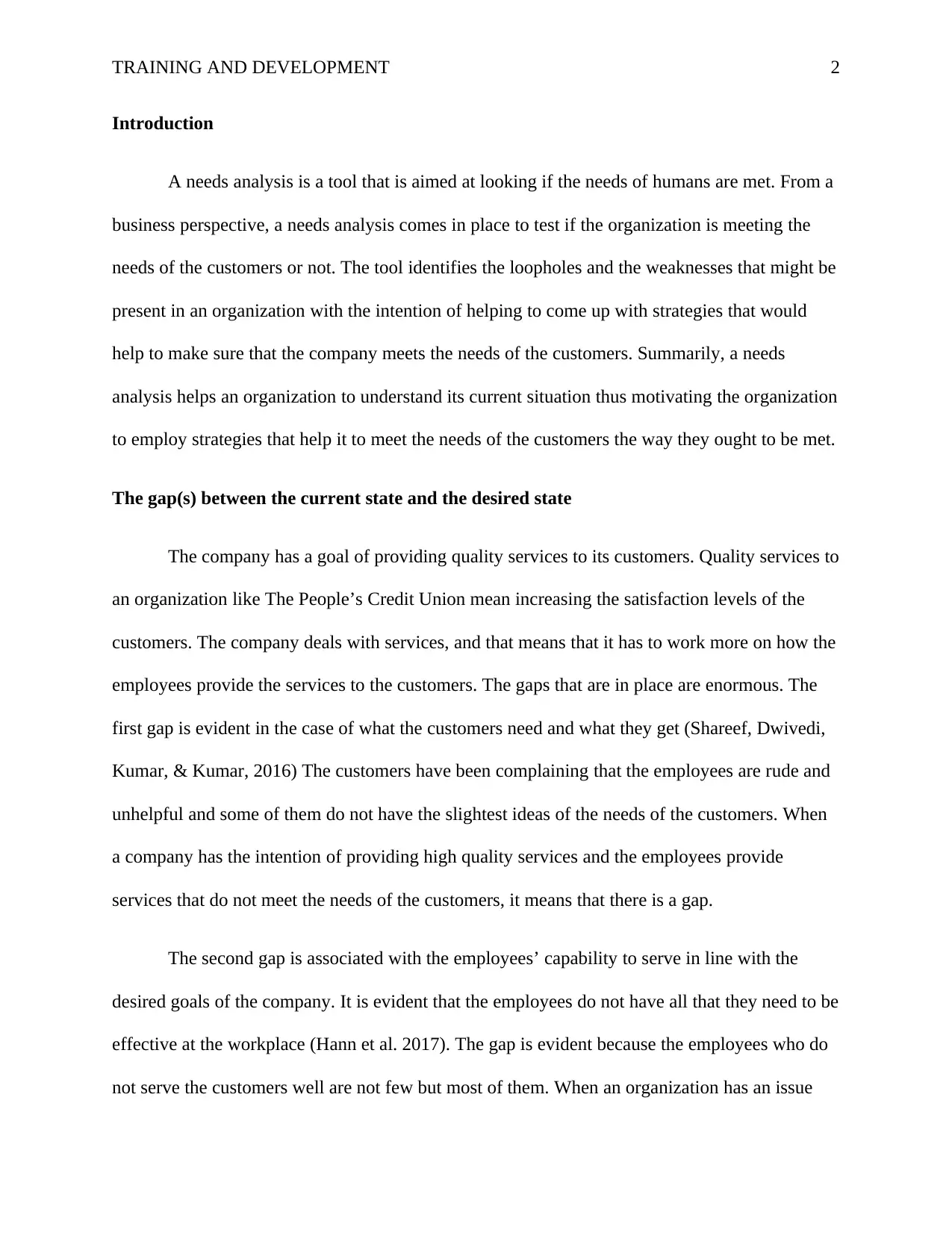
TRAINING AND DEVELOPMENT 2
Introduction
A needs analysis is a tool that is aimed at looking if the needs of humans are met. From a
business perspective, a needs analysis comes in place to test if the organization is meeting the
needs of the customers or not. The tool identifies the loopholes and the weaknesses that might be
present in an organization with the intention of helping to come up with strategies that would
help to make sure that the company meets the needs of the customers. Summarily, a needs
analysis helps an organization to understand its current situation thus motivating the organization
to employ strategies that help it to meet the needs of the customers the way they ought to be met.
The gap(s) between the current state and the desired state
The company has a goal of providing quality services to its customers. Quality services to
an organization like The People’s Credit Union mean increasing the satisfaction levels of the
customers. The company deals with services, and that means that it has to work more on how the
employees provide the services to the customers. The gaps that are in place are enormous. The
first gap is evident in the case of what the customers need and what they get (Shareef, Dwivedi,
Kumar, & Kumar, 2016) The customers have been complaining that the employees are rude and
unhelpful and some of them do not have the slightest ideas of the needs of the customers. When
a company has the intention of providing high quality services and the employees provide
services that do not meet the needs of the customers, it means that there is a gap.
The second gap is associated with the employees’ capability to serve in line with the
desired goals of the company. It is evident that the employees do not have all that they need to be
effective at the workplace (Hann et al. 2017). The gap is evident because the employees who do
not serve the customers well are not few but most of them. When an organization has an issue
Introduction
A needs analysis is a tool that is aimed at looking if the needs of humans are met. From a
business perspective, a needs analysis comes in place to test if the organization is meeting the
needs of the customers or not. The tool identifies the loopholes and the weaknesses that might be
present in an organization with the intention of helping to come up with strategies that would
help to make sure that the company meets the needs of the customers. Summarily, a needs
analysis helps an organization to understand its current situation thus motivating the organization
to employ strategies that help it to meet the needs of the customers the way they ought to be met.
The gap(s) between the current state and the desired state
The company has a goal of providing quality services to its customers. Quality services to
an organization like The People’s Credit Union mean increasing the satisfaction levels of the
customers. The company deals with services, and that means that it has to work more on how the
employees provide the services to the customers. The gaps that are in place are enormous. The
first gap is evident in the case of what the customers need and what they get (Shareef, Dwivedi,
Kumar, & Kumar, 2016) The customers have been complaining that the employees are rude and
unhelpful and some of them do not have the slightest ideas of the needs of the customers. When
a company has the intention of providing high quality services and the employees provide
services that do not meet the needs of the customers, it means that there is a gap.
The second gap is associated with the employees’ capability to serve in line with the
desired goals of the company. It is evident that the employees do not have all that they need to be
effective at the workplace (Hann et al. 2017). The gap is evident because the employees who do
not serve the customers well are not few but most of them. When an organization has an issue
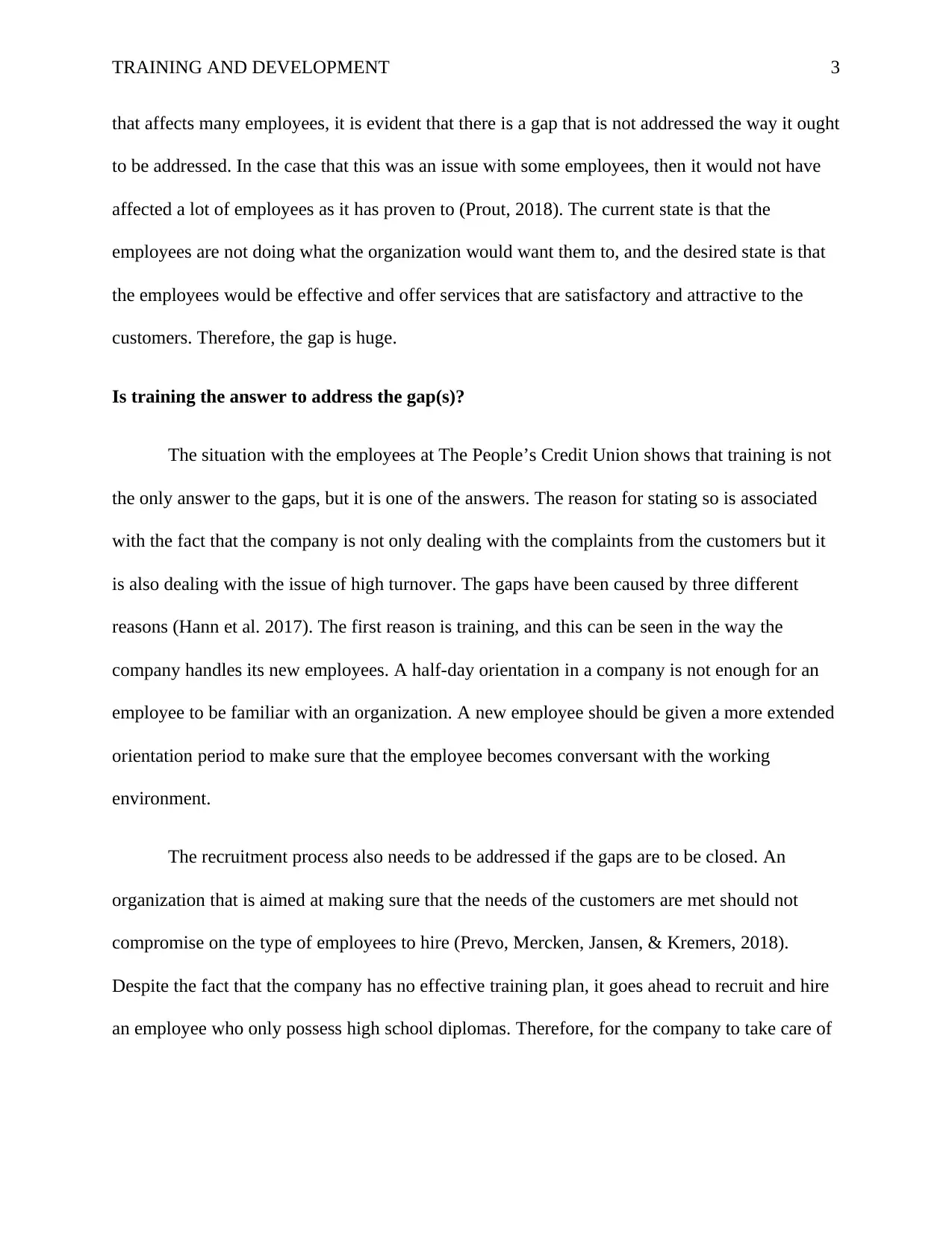
TRAINING AND DEVELOPMENT 3
that affects many employees, it is evident that there is a gap that is not addressed the way it ought
to be addressed. In the case that this was an issue with some employees, then it would not have
affected a lot of employees as it has proven to (Prout, 2018). The current state is that the
employees are not doing what the organization would want them to, and the desired state is that
the employees would be effective and offer services that are satisfactory and attractive to the
customers. Therefore, the gap is huge.
Is training the answer to address the gap(s)?
The situation with the employees at The People’s Credit Union shows that training is not
the only answer to the gaps, but it is one of the answers. The reason for stating so is associated
with the fact that the company is not only dealing with the complaints from the customers but it
is also dealing with the issue of high turnover. The gaps have been caused by three different
reasons (Hann et al. 2017). The first reason is training, and this can be seen in the way the
company handles its new employees. A half-day orientation in a company is not enough for an
employee to be familiar with an organization. A new employee should be given a more extended
orientation period to make sure that the employee becomes conversant with the working
environment.
The recruitment process also needs to be addressed if the gaps are to be closed. An
organization that is aimed at making sure that the needs of the customers are met should not
compromise on the type of employees to hire (Prevo, Mercken, Jansen, & Kremers, 2018).
Despite the fact that the company has no effective training plan, it goes ahead to recruit and hire
an employee who only possess high school diplomas. Therefore, for the company to take care of
that affects many employees, it is evident that there is a gap that is not addressed the way it ought
to be addressed. In the case that this was an issue with some employees, then it would not have
affected a lot of employees as it has proven to (Prout, 2018). The current state is that the
employees are not doing what the organization would want them to, and the desired state is that
the employees would be effective and offer services that are satisfactory and attractive to the
customers. Therefore, the gap is huge.
Is training the answer to address the gap(s)?
The situation with the employees at The People’s Credit Union shows that training is not
the only answer to the gaps, but it is one of the answers. The reason for stating so is associated
with the fact that the company is not only dealing with the complaints from the customers but it
is also dealing with the issue of high turnover. The gaps have been caused by three different
reasons (Hann et al. 2017). The first reason is training, and this can be seen in the way the
company handles its new employees. A half-day orientation in a company is not enough for an
employee to be familiar with an organization. A new employee should be given a more extended
orientation period to make sure that the employee becomes conversant with the working
environment.
The recruitment process also needs to be addressed if the gaps are to be closed. An
organization that is aimed at making sure that the needs of the customers are met should not
compromise on the type of employees to hire (Prevo, Mercken, Jansen, & Kremers, 2018).
Despite the fact that the company has no effective training plan, it goes ahead to recruit and hire
an employee who only possess high school diplomas. Therefore, for the company to take care of
⊘ This is a preview!⊘
Do you want full access?
Subscribe today to unlock all pages.

Trusted by 1+ million students worldwide
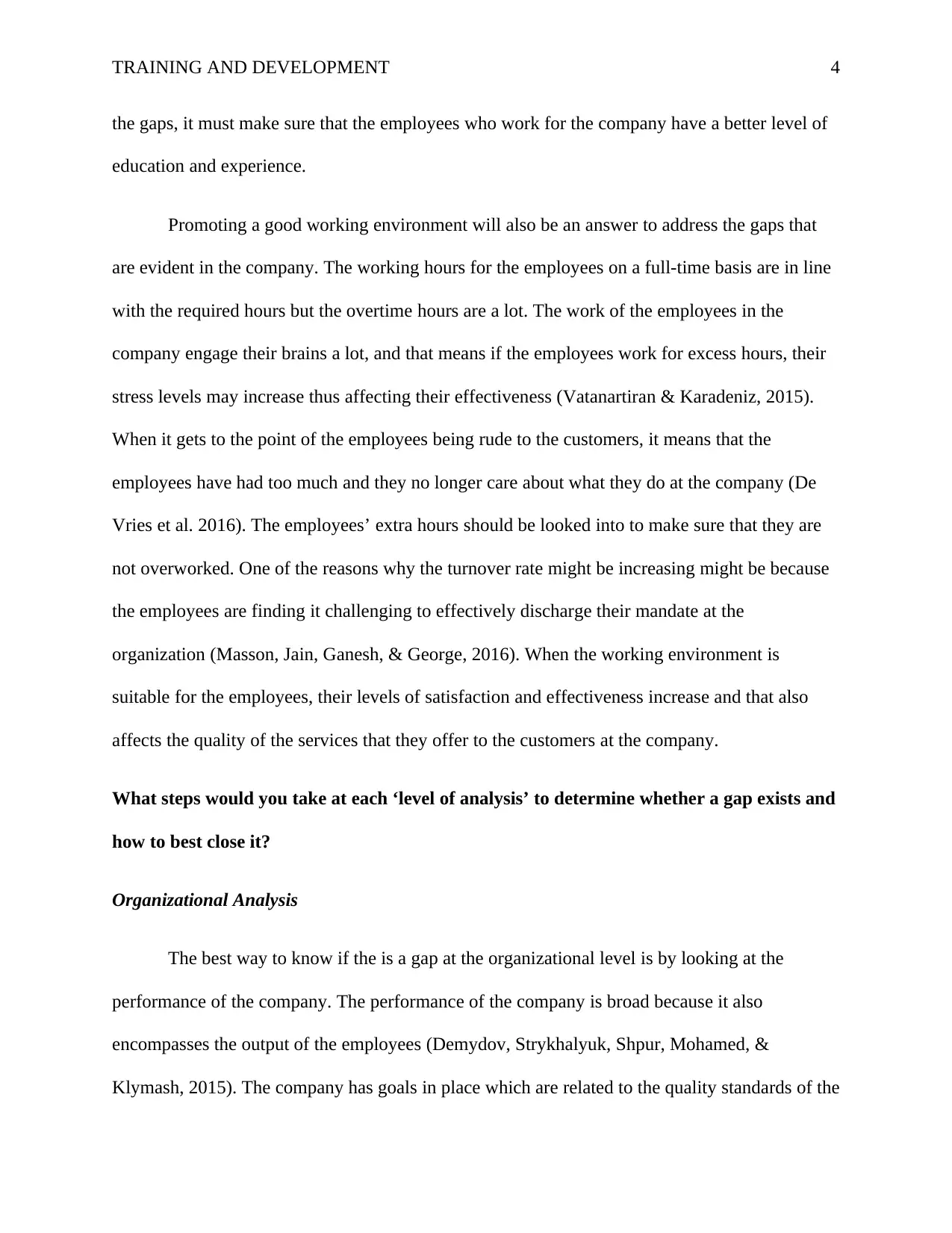
TRAINING AND DEVELOPMENT 4
the gaps, it must make sure that the employees who work for the company have a better level of
education and experience.
Promoting a good working environment will also be an answer to address the gaps that
are evident in the company. The working hours for the employees on a full-time basis are in line
with the required hours but the overtime hours are a lot. The work of the employees in the
company engage their brains a lot, and that means if the employees work for excess hours, their
stress levels may increase thus affecting their effectiveness (Vatanartiran & Karadeniz, 2015).
When it gets to the point of the employees being rude to the customers, it means that the
employees have had too much and they no longer care about what they do at the company (De
Vries et al. 2016). The employees’ extra hours should be looked into to make sure that they are
not overworked. One of the reasons why the turnover rate might be increasing might be because
the employees are finding it challenging to effectively discharge their mandate at the
organization (Masson, Jain, Ganesh, & George, 2016). When the working environment is
suitable for the employees, their levels of satisfaction and effectiveness increase and that also
affects the quality of the services that they offer to the customers at the company.
What steps would you take at each ‘level of analysis’ to determine whether a gap exists and
how to best close it?
Organizational Analysis
The best way to know if the is a gap at the organizational level is by looking at the
performance of the company. The performance of the company is broad because it also
encompasses the output of the employees (Demydov, Strykhalyuk, Shpur, Mohamed, &
Klymash, 2015). The company has goals in place which are related to the quality standards of the
the gaps, it must make sure that the employees who work for the company have a better level of
education and experience.
Promoting a good working environment will also be an answer to address the gaps that
are evident in the company. The working hours for the employees on a full-time basis are in line
with the required hours but the overtime hours are a lot. The work of the employees in the
company engage their brains a lot, and that means if the employees work for excess hours, their
stress levels may increase thus affecting their effectiveness (Vatanartiran & Karadeniz, 2015).
When it gets to the point of the employees being rude to the customers, it means that the
employees have had too much and they no longer care about what they do at the company (De
Vries et al. 2016). The employees’ extra hours should be looked into to make sure that they are
not overworked. One of the reasons why the turnover rate might be increasing might be because
the employees are finding it challenging to effectively discharge their mandate at the
organization (Masson, Jain, Ganesh, & George, 2016). When the working environment is
suitable for the employees, their levels of satisfaction and effectiveness increase and that also
affects the quality of the services that they offer to the customers at the company.
What steps would you take at each ‘level of analysis’ to determine whether a gap exists and
how to best close it?
Organizational Analysis
The best way to know if the is a gap at the organizational level is by looking at the
performance of the company. The performance of the company is broad because it also
encompasses the output of the employees (Demydov, Strykhalyuk, Shpur, Mohamed, &
Klymash, 2015). The company has goals in place which are related to the quality standards of the
Paraphrase This Document
Need a fresh take? Get an instant paraphrase of this document with our AI Paraphraser
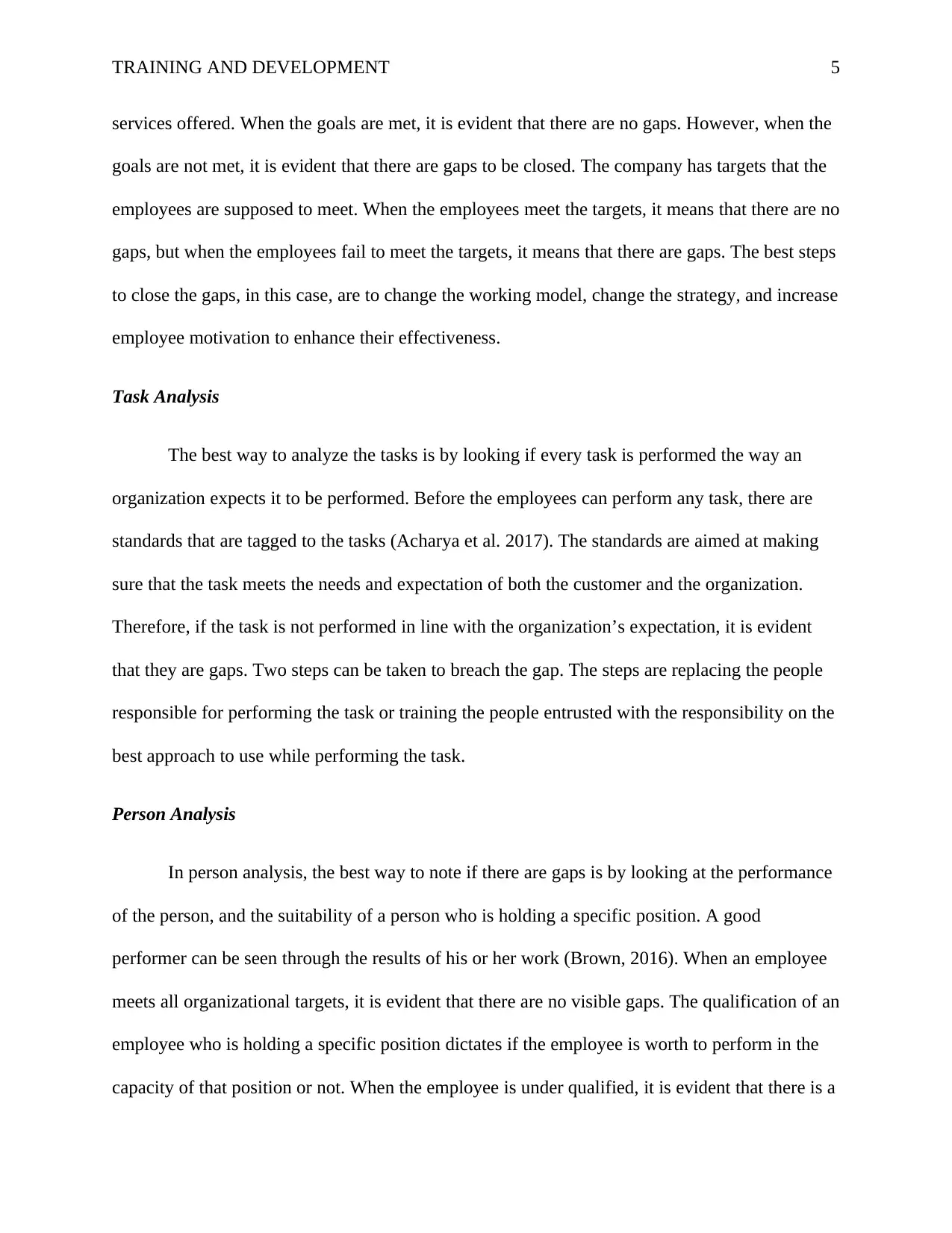
TRAINING AND DEVELOPMENT 5
services offered. When the goals are met, it is evident that there are no gaps. However, when the
goals are not met, it is evident that there are gaps to be closed. The company has targets that the
employees are supposed to meet. When the employees meet the targets, it means that there are no
gaps, but when the employees fail to meet the targets, it means that there are gaps. The best steps
to close the gaps, in this case, are to change the working model, change the strategy, and increase
employee motivation to enhance their effectiveness.
Task Analysis
The best way to analyze the tasks is by looking if every task is performed the way an
organization expects it to be performed. Before the employees can perform any task, there are
standards that are tagged to the tasks (Acharya et al. 2017). The standards are aimed at making
sure that the task meets the needs and expectation of both the customer and the organization.
Therefore, if the task is not performed in line with the organization’s expectation, it is evident
that they are gaps. Two steps can be taken to breach the gap. The steps are replacing the people
responsible for performing the task or training the people entrusted with the responsibility on the
best approach to use while performing the task.
Person Analysis
In person analysis, the best way to note if there are gaps is by looking at the performance
of the person, and the suitability of a person who is holding a specific position. A good
performer can be seen through the results of his or her work (Brown, 2016). When an employee
meets all organizational targets, it is evident that there are no visible gaps. The qualification of an
employee who is holding a specific position dictates if the employee is worth to perform in the
capacity of that position or not. When the employee is under qualified, it is evident that there is a
services offered. When the goals are met, it is evident that there are no gaps. However, when the
goals are not met, it is evident that there are gaps to be closed. The company has targets that the
employees are supposed to meet. When the employees meet the targets, it means that there are no
gaps, but when the employees fail to meet the targets, it means that there are gaps. The best steps
to close the gaps, in this case, are to change the working model, change the strategy, and increase
employee motivation to enhance their effectiveness.
Task Analysis
The best way to analyze the tasks is by looking if every task is performed the way an
organization expects it to be performed. Before the employees can perform any task, there are
standards that are tagged to the tasks (Acharya et al. 2017). The standards are aimed at making
sure that the task meets the needs and expectation of both the customer and the organization.
Therefore, if the task is not performed in line with the organization’s expectation, it is evident
that they are gaps. Two steps can be taken to breach the gap. The steps are replacing the people
responsible for performing the task or training the people entrusted with the responsibility on the
best approach to use while performing the task.
Person Analysis
In person analysis, the best way to note if there are gaps is by looking at the performance
of the person, and the suitability of a person who is holding a specific position. A good
performer can be seen through the results of his or her work (Brown, 2016). When an employee
meets all organizational targets, it is evident that there are no visible gaps. The qualification of an
employee who is holding a specific position dictates if the employee is worth to perform in the
capacity of that position or not. When the employee is under qualified, it is evident that there is a
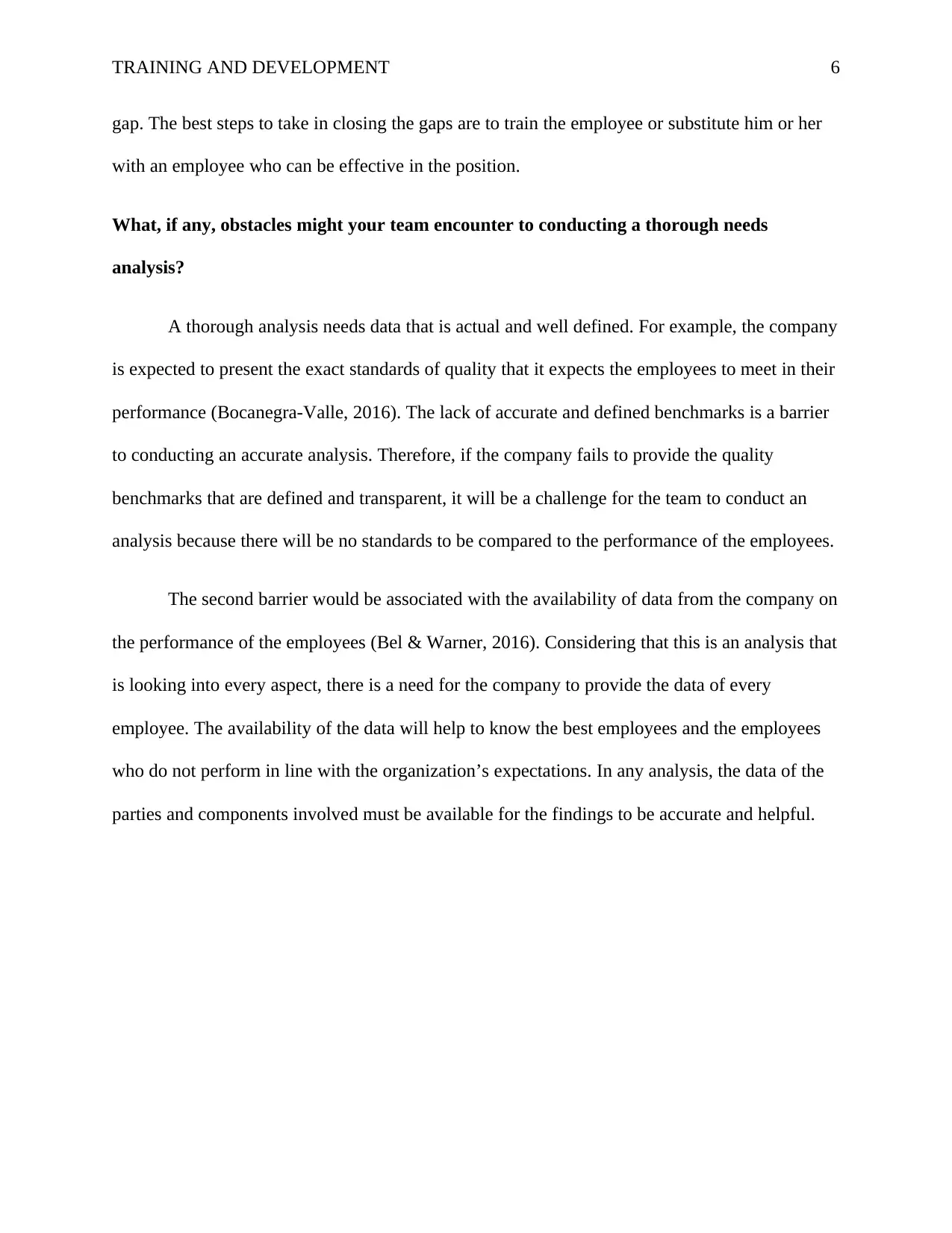
TRAINING AND DEVELOPMENT 6
gap. The best steps to take in closing the gaps are to train the employee or substitute him or her
with an employee who can be effective in the position.
What, if any, obstacles might your team encounter to conducting a thorough needs
analysis?
A thorough analysis needs data that is actual and well defined. For example, the company
is expected to present the exact standards of quality that it expects the employees to meet in their
performance (Bocanegra-Valle, 2016). The lack of accurate and defined benchmarks is a barrier
to conducting an accurate analysis. Therefore, if the company fails to provide the quality
benchmarks that are defined and transparent, it will be a challenge for the team to conduct an
analysis because there will be no standards to be compared to the performance of the employees.
The second barrier would be associated with the availability of data from the company on
the performance of the employees (Bel & Warner, 2016). Considering that this is an analysis that
is looking into every aspect, there is a need for the company to provide the data of every
employee. The availability of the data will help to know the best employees and the employees
who do not perform in line with the organization’s expectations. In any analysis, the data of the
parties and components involved must be available for the findings to be accurate and helpful.
gap. The best steps to take in closing the gaps are to train the employee or substitute him or her
with an employee who can be effective in the position.
What, if any, obstacles might your team encounter to conducting a thorough needs
analysis?
A thorough analysis needs data that is actual and well defined. For example, the company
is expected to present the exact standards of quality that it expects the employees to meet in their
performance (Bocanegra-Valle, 2016). The lack of accurate and defined benchmarks is a barrier
to conducting an accurate analysis. Therefore, if the company fails to provide the quality
benchmarks that are defined and transparent, it will be a challenge for the team to conduct an
analysis because there will be no standards to be compared to the performance of the employees.
The second barrier would be associated with the availability of data from the company on
the performance of the employees (Bel & Warner, 2016). Considering that this is an analysis that
is looking into every aspect, there is a need for the company to provide the data of every
employee. The availability of the data will help to know the best employees and the employees
who do not perform in line with the organization’s expectations. In any analysis, the data of the
parties and components involved must be available for the findings to be accurate and helpful.
⊘ This is a preview!⊘
Do you want full access?
Subscribe today to unlock all pages.

Trusted by 1+ million students worldwide
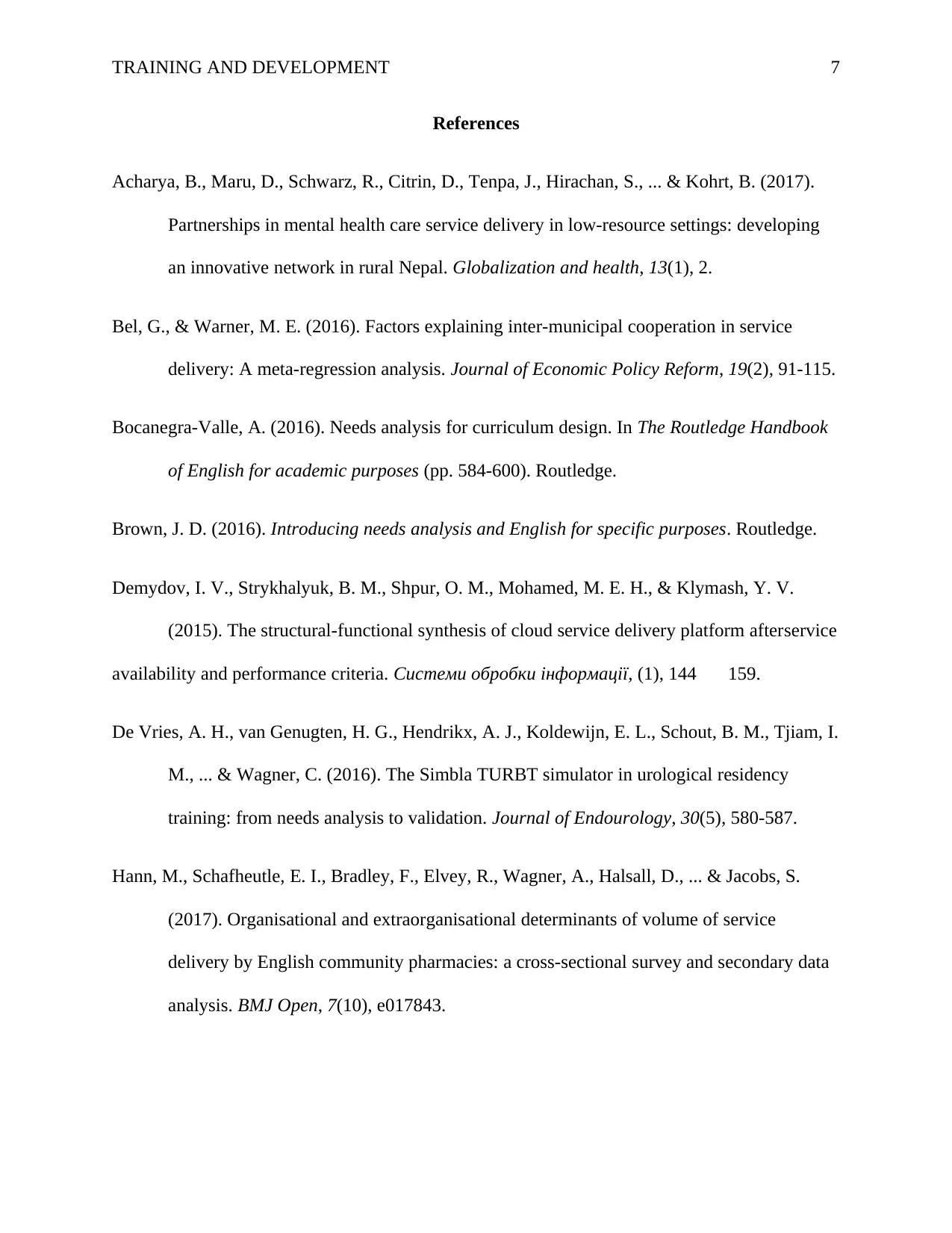
TRAINING AND DEVELOPMENT 7
References
Acharya, B., Maru, D., Schwarz, R., Citrin, D., Tenpa, J., Hirachan, S., ... & Kohrt, B. (2017).
Partnerships in mental health care service delivery in low-resource settings: developing
an innovative network in rural Nepal. Globalization and health, 13(1), 2.
Bel, G., & Warner, M. E. (2016). Factors explaining inter-municipal cooperation in service
delivery: A meta-regression analysis. Journal of Economic Policy Reform, 19(2), 91-115.
Bocanegra-Valle, A. (2016). Needs analysis for curriculum design. In The Routledge Handbook
of English for academic purposes (pp. 584-600). Routledge.
Brown, J. D. (2016). Introducing needs analysis and English for specific purposes. Routledge.
Demydov, I. V., Strykhalyuk, B. M., Shpur, O. M., Mohamed, M. E. H., & Klymash, Y. V.
(2015). The structural-functional synthesis of cloud service delivery platform afterservice
availability and performance criteria. Системи обробки інформації, (1), 144 159.
De Vries, A. H., van Genugten, H. G., Hendrikx, A. J., Koldewijn, E. L., Schout, B. M., Tjiam, I.
M., ... & Wagner, C. (2016). The Simbla TURBT simulator in urological residency
training: from needs analysis to validation. Journal of Endourology, 30(5), 580-587.
Hann, M., Schafheutle, E. I., Bradley, F., Elvey, R., Wagner, A., Halsall, D., ... & Jacobs, S.
(2017). Organisational and extraorganisational determinants of volume of service
delivery by English community pharmacies: a cross-sectional survey and secondary data
analysis. BMJ Open, 7(10), e017843.
References
Acharya, B., Maru, D., Schwarz, R., Citrin, D., Tenpa, J., Hirachan, S., ... & Kohrt, B. (2017).
Partnerships in mental health care service delivery in low-resource settings: developing
an innovative network in rural Nepal. Globalization and health, 13(1), 2.
Bel, G., & Warner, M. E. (2016). Factors explaining inter-municipal cooperation in service
delivery: A meta-regression analysis. Journal of Economic Policy Reform, 19(2), 91-115.
Bocanegra-Valle, A. (2016). Needs analysis for curriculum design. In The Routledge Handbook
of English for academic purposes (pp. 584-600). Routledge.
Brown, J. D. (2016). Introducing needs analysis and English for specific purposes. Routledge.
Demydov, I. V., Strykhalyuk, B. M., Shpur, O. M., Mohamed, M. E. H., & Klymash, Y. V.
(2015). The structural-functional synthesis of cloud service delivery platform afterservice
availability and performance criteria. Системи обробки інформації, (1), 144 159.
De Vries, A. H., van Genugten, H. G., Hendrikx, A. J., Koldewijn, E. L., Schout, B. M., Tjiam, I.
M., ... & Wagner, C. (2016). The Simbla TURBT simulator in urological residency
training: from needs analysis to validation. Journal of Endourology, 30(5), 580-587.
Hann, M., Schafheutle, E. I., Bradley, F., Elvey, R., Wagner, A., Halsall, D., ... & Jacobs, S.
(2017). Organisational and extraorganisational determinants of volume of service
delivery by English community pharmacies: a cross-sectional survey and secondary data
analysis. BMJ Open, 7(10), e017843.
Paraphrase This Document
Need a fresh take? Get an instant paraphrase of this document with our AI Paraphraser
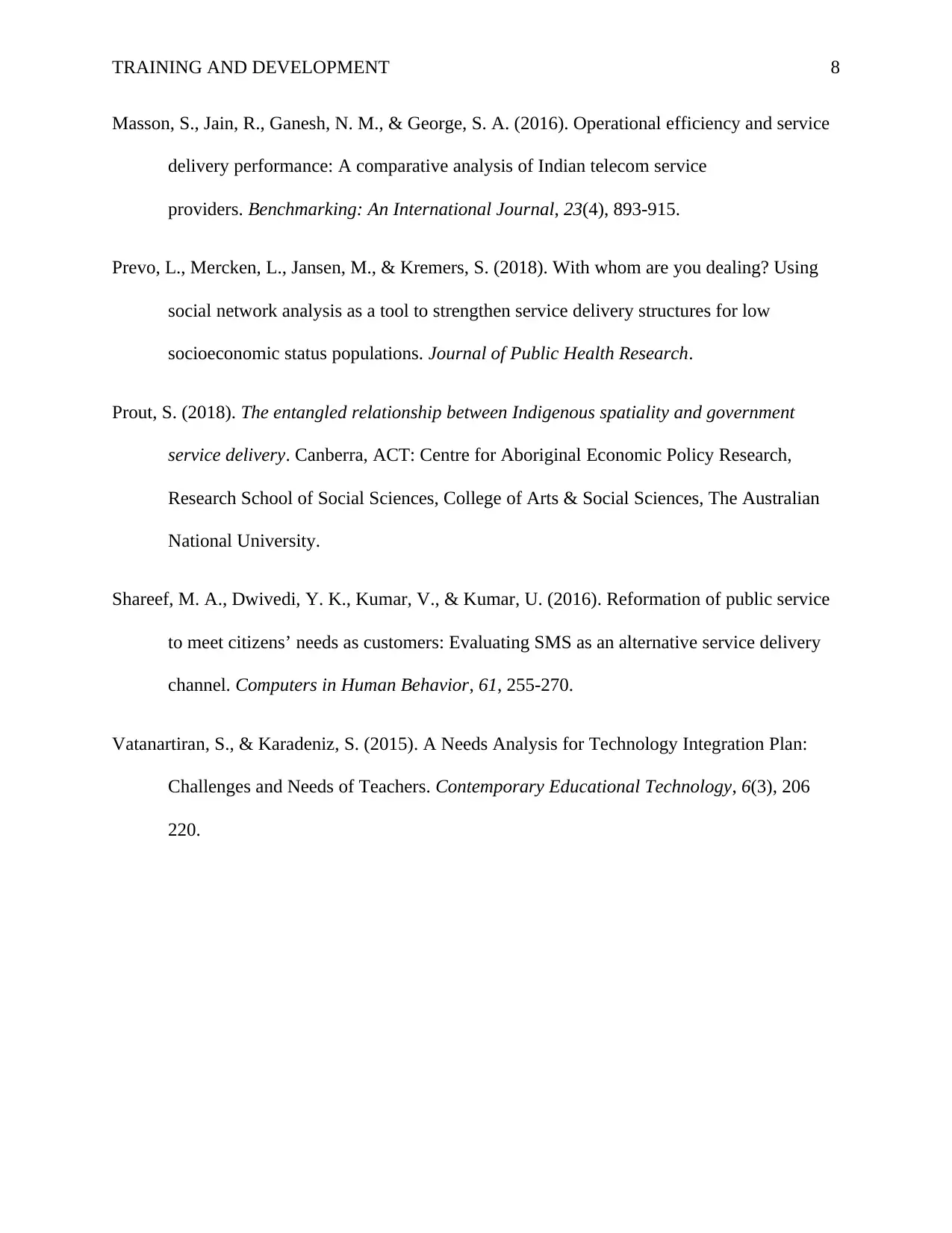
TRAINING AND DEVELOPMENT 8
Masson, S., Jain, R., Ganesh, N. M., & George, S. A. (2016). Operational efficiency and service
delivery performance: A comparative analysis of Indian telecom service
providers. Benchmarking: An International Journal, 23(4), 893-915.
Prevo, L., Mercken, L., Jansen, M., & Kremers, S. (2018). With whom are you dealing? Using
social network analysis as a tool to strengthen service delivery structures for low
socioeconomic status populations. Journal of Public Health Research.
Prout, S. (2018). The entangled relationship between Indigenous spatiality and government
service delivery. Canberra, ACT: Centre for Aboriginal Economic Policy Research,
Research School of Social Sciences, College of Arts & Social Sciences, The Australian
National University.
Shareef, M. A., Dwivedi, Y. K., Kumar, V., & Kumar, U. (2016). Reformation of public service
to meet citizens’ needs as customers: Evaluating SMS as an alternative service delivery
channel. Computers in Human Behavior, 61, 255-270.
Vatanartiran, S., & Karadeniz, S. (2015). A Needs Analysis for Technology Integration Plan:
Challenges and Needs of Teachers. Contemporary Educational Technology, 6(3), 206
220.
Masson, S., Jain, R., Ganesh, N. M., & George, S. A. (2016). Operational efficiency and service
delivery performance: A comparative analysis of Indian telecom service
providers. Benchmarking: An International Journal, 23(4), 893-915.
Prevo, L., Mercken, L., Jansen, M., & Kremers, S. (2018). With whom are you dealing? Using
social network analysis as a tool to strengthen service delivery structures for low
socioeconomic status populations. Journal of Public Health Research.
Prout, S. (2018). The entangled relationship between Indigenous spatiality and government
service delivery. Canberra, ACT: Centre for Aboriginal Economic Policy Research,
Research School of Social Sciences, College of Arts & Social Sciences, The Australian
National University.
Shareef, M. A., Dwivedi, Y. K., Kumar, V., & Kumar, U. (2016). Reformation of public service
to meet citizens’ needs as customers: Evaluating SMS as an alternative service delivery
channel. Computers in Human Behavior, 61, 255-270.
Vatanartiran, S., & Karadeniz, S. (2015). A Needs Analysis for Technology Integration Plan:
Challenges and Needs of Teachers. Contemporary Educational Technology, 6(3), 206
220.
1 out of 8
Related Documents
Your All-in-One AI-Powered Toolkit for Academic Success.
+13062052269
info@desklib.com
Available 24*7 on WhatsApp / Email
![[object Object]](/_next/static/media/star-bottom.7253800d.svg)
Unlock your academic potential
Copyright © 2020–2025 A2Z Services. All Rights Reserved. Developed and managed by ZUCOL.




